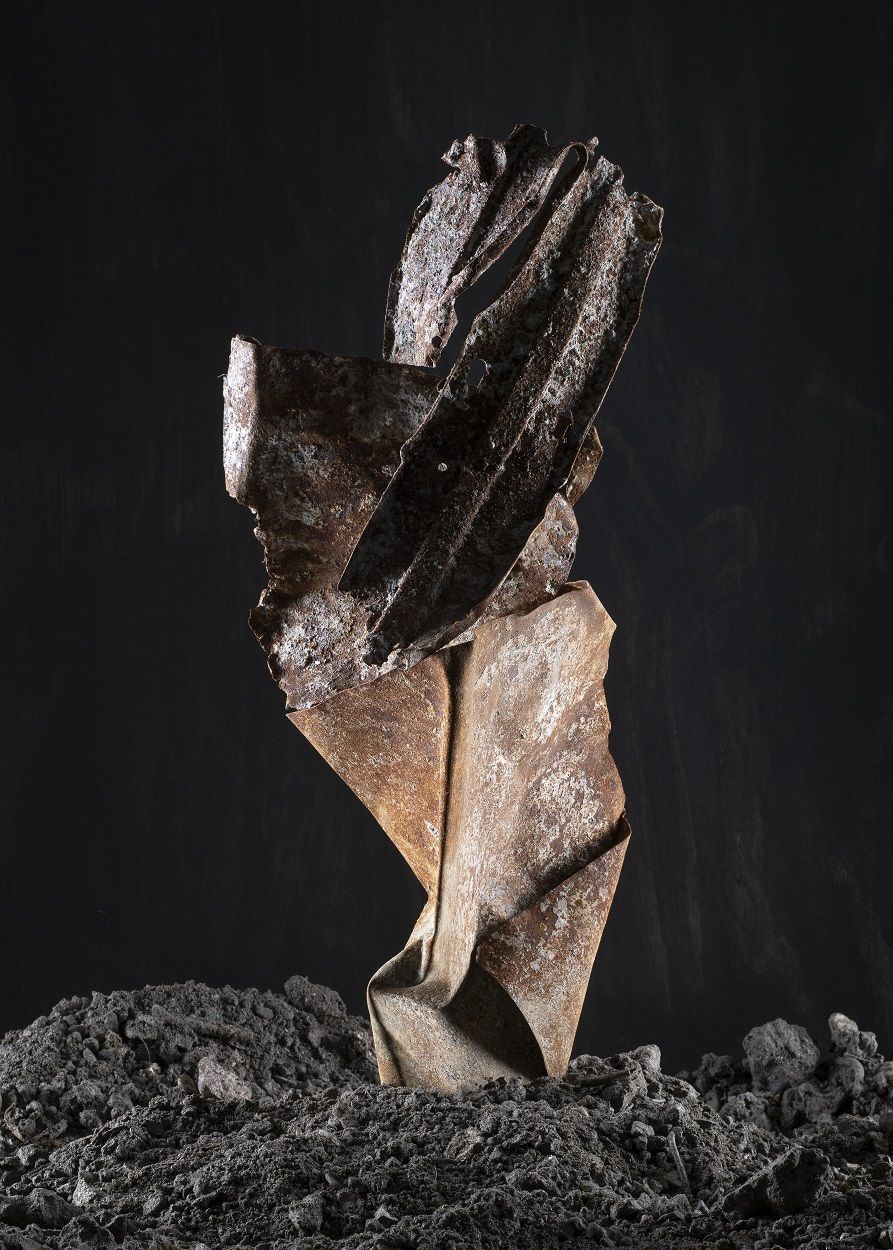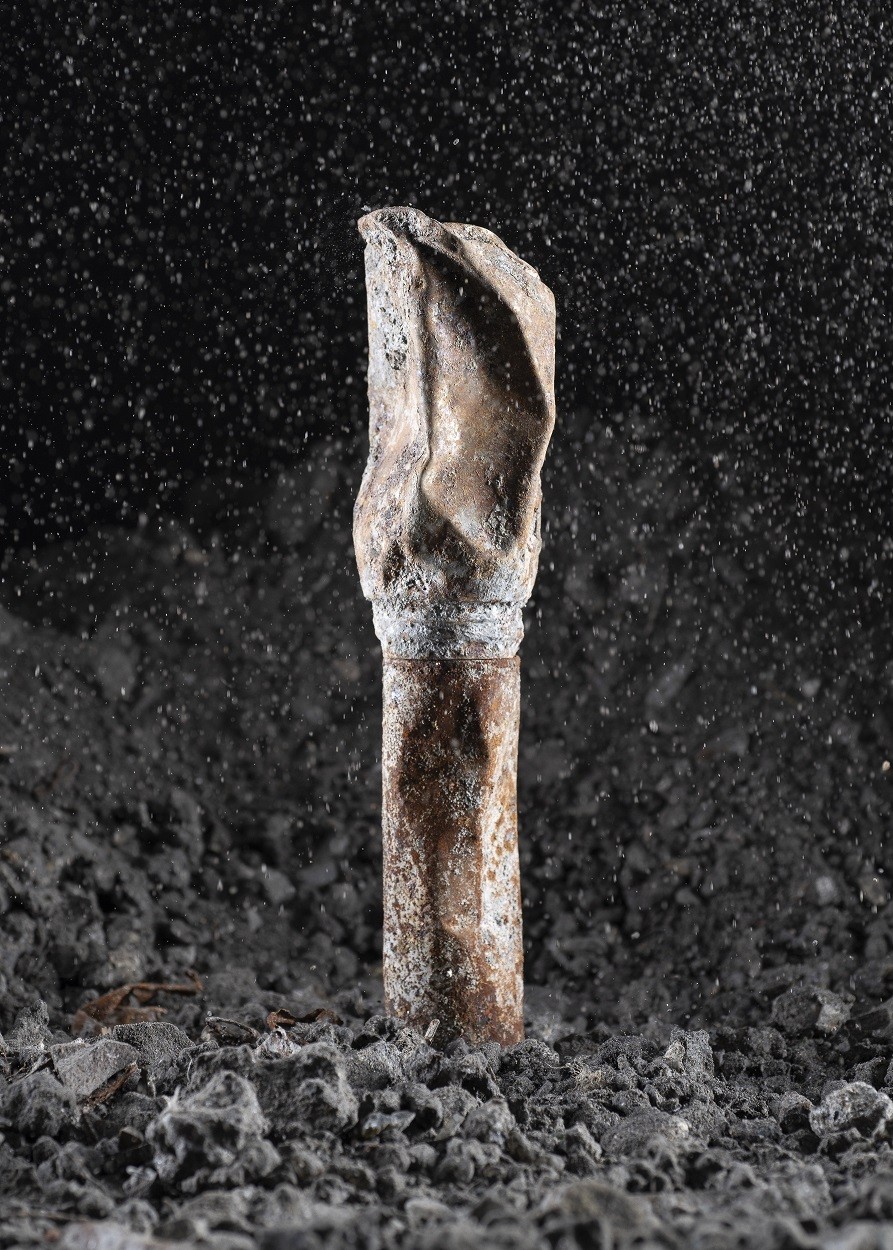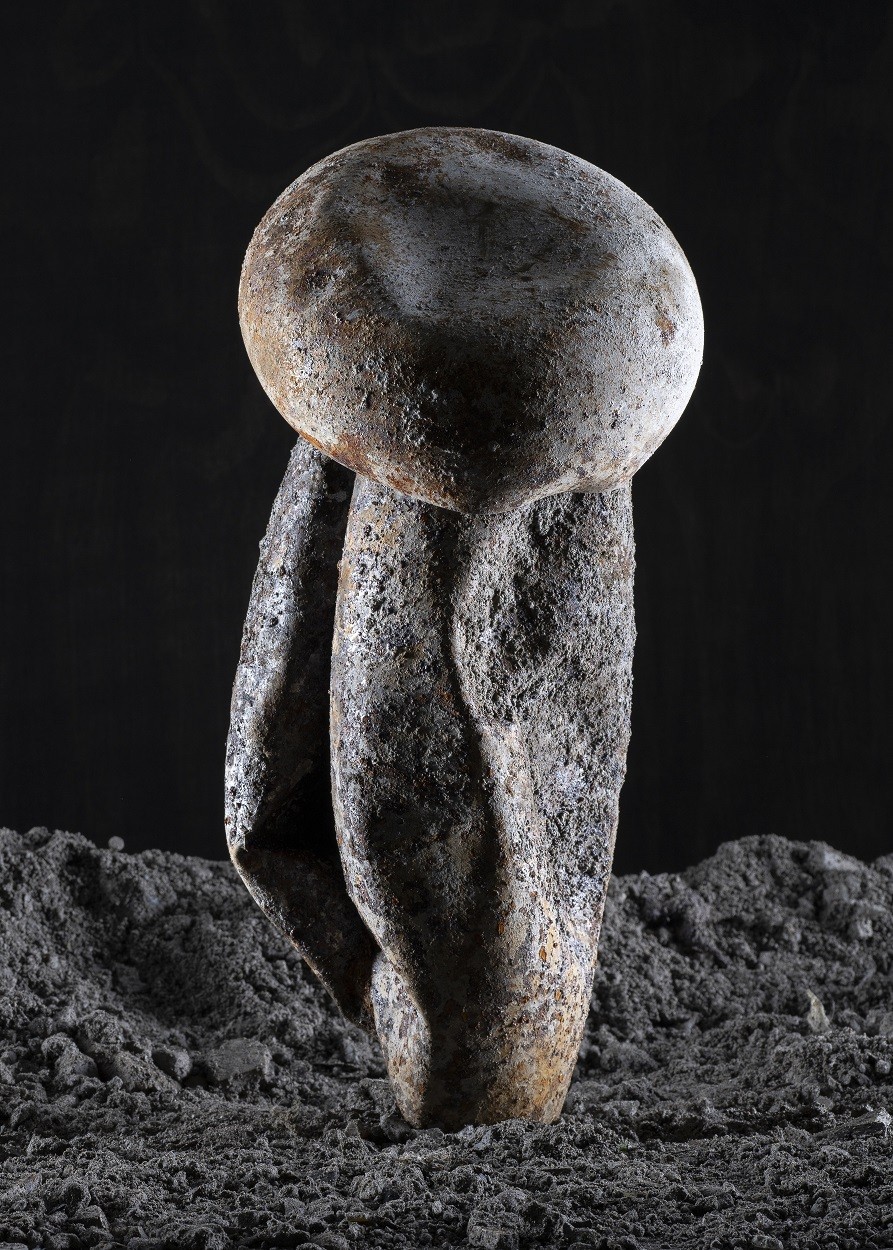SJOERD KNIBBELER | PASSANTEN
Past / Present door Raphaëlle Stopin
First, there is this soil of a deep, muted grey; a powerful side-lighting, coming from off-camera, reveals the material: certainly ashes. We weigh it, even smell it with a look, it is hardy, heavy, maybe even a bit greasy, and undoubtedly very bitter. Its composition is heterogeneous: Concretions are mixed within the fine dust, small heaps of pockmarked reliefs, as if in a perpetual state of collapse.
Spread out in a fine layer, it discretely covers the lower part of the image and yet it is the base for everything. Is the earth beneath these moon extracts even our own? We should fear that it is.
Firmly planted, solitary forms emerge from it. Each of these accumulated silhouettes is without equal and looking more closely at their different limbs doesn’t reveal anything more about them. No usage, no identifiable past: pure presence. Each covers the quasi-totality of the visual field. They all rise up. How could we, when observing their confident verticality, not anthropomorphise them and acknowledge their attitude, or even grant them a strange determination.
The shapes are baleful, twisted, they tell tales of the powers they have gone through: an extreme heat and pressure, which alone are capable of bending their steel skeleton. Their corroded patina invites time itself into the picture: who else but she could wear out their skin like that?
Their current functionality is unknown, improbable; their past functionality lost. They were, we can guess, technical objects. Of their perfection, their ergonomics, their utility and the performance that was asked of them nothing remains. Nothing but their maimed bodies and their used skin. In a strangely empathetic movement, our hands remember them. There was a time when they passed through our fingers, which moved their buttons or springs. Before that time, they were modelled, constructed, and even before that, designed, imagined. In 1958 the philosopher Gilbert Simondon dedicated a groundbreaking text to the technical object: On the Mode of Existence of Technical Objects. He invited us to rethink our relationship with technology, to overcome our strictly utilitarian view of the technical object and proposed to not view it for its results and the human needs it responded to, but as an outcome. He therefore described the machine as “a fixed, deposed human gesture that has become stereotypy and a possibility for renewal.”[1] It’s the sediment of a human action that crystallizes in the object. So, in the glowing red silhouettes of any object, whatever it might be, we look at our own humanity and its gestures.
[1] On the Mode of Existence of Technical Objects, Minneapolis: Univocal Publishing, 2016.
It is that chain of gestures in which the work by Dutch artist Sjoerd Knibbeler, creator of this series of nineteen photo portraits entitled Les Passants, inscribes itself. After he had been invited by EEW Energy from Waste to create a work of art inspired by the work realised in their factories, he visited the one in Delfzijl, in the province of Groningen, in the northeast of the Netherlands. Boats from all over Europe unload their waste there every day. It is mixed, then incinerated; the rising steam activates a turbine that is connected to a generator through which it is transformed into energy of such a quantity to power the surrounding industry. On site, the architecture and infrastructure impose their monumental presence; but instead of being interested in the instruments of transformation, Sjoerd Knibbeler would prefer focusing on the waste itself or, to be more precise, the waste of the waste – the ashes that remain after the combustion. As the last stage in the process of recycling, these bottom ashes themselves are the object of a sorting and cleaning process before they become part of the raw material that is used for road surfaces. They form giant, black mountains that Sjoerd Knibbeler would be climbing and measuring.
He makes a broad selection at first, extracting objects that have resisted the combustion. In the course of his expeditions, he becomes more selective and thus completes his collection of shapes. Placed in hermetically sealed tons, he brings the objects to his workshop to take portraits of them. It’s a mini studio he has set-up on site: A space is defined, a kind of small theatre with a black background and lighting from both sides. The artist chooses a minimalistic staging, relying exclusively on lighting effects without any other accessories or artifice. His approach is a simple visual syntax for objects that are themselves shown in their simplest form. Through these few determined elements – light, shades of grey, solid shapes – he creates chiselled images. In these almost monochrome landscapes, the rust contrasts. Ochre, red, orange, pale, intense… alive… it unfolds the effect of nuanced carnations on these shapes.
The gestures of extracting and then photographing by Sjoerd Knibbeler continue this chain of gestures through which the technical object emerges. And they put into motion the social relationship that the philosopher Simondon desired and which is, in his view, hindered by two contradictory attitudes. The first one is to only consider the object for the sole human desire that it can satisfy; the second is to fantasize the machine as something which has been given powers (the mythical robot, too clever to not quickly become a threat). Here, they are photographed in a way that prevents them from revealing the original use that had been assigned to them. They are, as the philosopher would say, freed from their “enslavement”, and are equally unable to play the role of the idolized and feared android; they seem to be vague and vulnerable. “Therefore”, wrote the philosopher, “the first prerequisite for the incorporation of the technical objects into culture is that man is neither inferior nor superior to technical objects, that he can approach them and get to know them by entering into a relationship of equality, of reciprocal exchange: a social relationship in every sense.”[1] And so the artist that has chosen the medium of photography naturally proposes a portrait session to his Passants.
It could be said that, however mysterious they might appear at first glance, these objects are what they are: waste, our waste, even worse, the waste of waste. They will not fall any lower. And as fallen objects, they occupy what Bruno Latour has called “ghost hectares”. In Critical Zones, The Science and Politics of Landing on Earth[2], he exposes the fact that “we don’t live where we are”. By continuing Georg Borgströms concept of “ghost acreage”[3], meaning the far-off lands from which a country lives (the colonies in the past, nowadays the countries that work as factories for palm oil, the textile industry, the famous Made in), he extends it to that “Critical Zone” that our whole planet has become. The critical zone lies in this thin layer, miniscule in relation to the mass of the earth, which includes soil, ores, minerals, air, and water. It is living through critical times, and we are only partially perceiving it because of that orchestrated distance. We are not living in the places on which we leave our footprint. How then can we represent these ghost spaces, these places whose soil has been scarred by us from afar? Sjoerd Knibbeler has dedicated previous works to the representation of elements as changing and elusive as water and wind. Here he is, engaging in the creation of a different kind of iconography: this time, the absent image that he seeks to bring into the world is that of a present that leaves its mark everywhere, but hides from our eyes. These totems will make us remember it, they aren’t the ruins of past cataclysms, but companions of a shared present that must be faced head-on.
[1] ibidem.
[2] Critical Zones, The Science and Politics of Landing on Earth, Edited by Bruno Latour and Peter Weibel, ZKM – MIT Press, 2020.
[3] Georg Borgström: Ghost Acreage, in: Libby Robin, Sverker Sörlin, Paul Warde (Hrsg.): The Future of Nature: Documents of Global Change, Yale University Press 2013.


